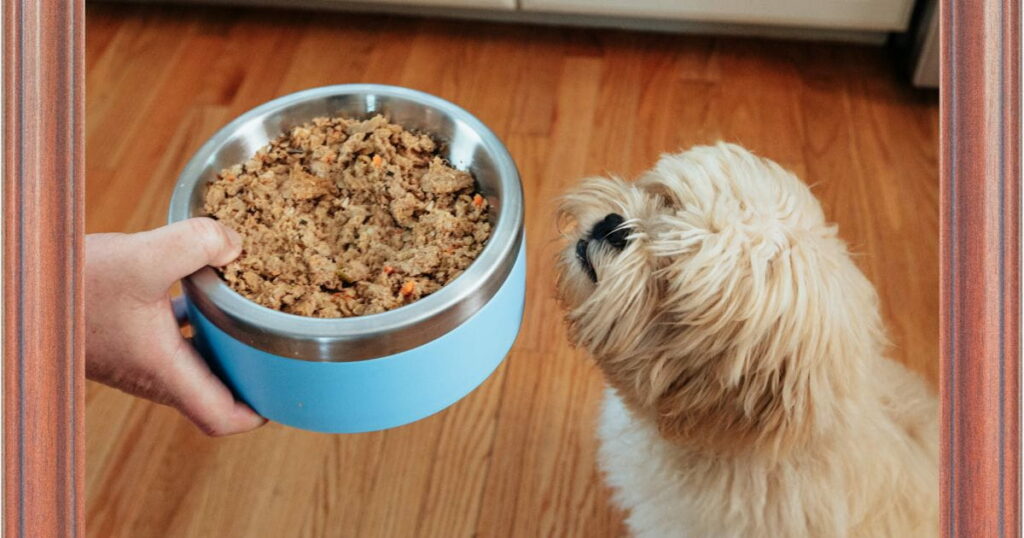As a puppy owner, one of the essential aspects of their care revolves around feeding. The question of how often to feed your furry friend is a crucial one, directly influencing their growth, health, and overall well-being.
In this comprehensive guide, we will explore every facet of puppy feeding frequency, guiding you through the various stages of your puppy’s development and providing insights to help you make informed decisions.

Factors Influencing Feeding Frequency
The foundation of nourishing your puppy hinges upon grasping the factors that intricately shape their dietary requirements. It’s a journey that begins with a profound understanding of the elements that influence how often your furry companion should be fed.
Among these determinants, age, and breed emerge as pivotal players, casting a significant impact on your puppy’s feeding frequency.
Puppies stand apart from their adult counterparts, equipped with distinct nutritional demands. These needs, like the pup’s growth itself, metamorphose over time.
Smaller breeds, boasting faster metabolic rates, necessitate more frequent meals to satiate their energetic pace. In contrast, larger breeds demand an artful dance of portion control to ward off precipitous growth.
The Nursing Phase: Newborn to 3 Weeks
In the initial weeks of a puppy’s existence, a symphony of life plays out as they rely entirely on the nourishment bestowed by their mother’s milk. This phase is not merely a formative one but a critical chapter in their tale of development.
Mother’s milk emerges as an elixir of sustenance, brimming with vital nutrients and the invaluable gift of antibodies.
It’s a sustenance that transcends mere nutrition – it fortifies their immune system, paves the way for growth, and imbues them with the resilience needed to navigate the world. While the direct act of feeding during this phase lies beyond your reach, the onus remains on you to ensure that the mother is both robust and well-fed.
By safeguarding her well-being, you indirectly contribute to the well-being of the puppies entrusted in her care.
Transition to Solid Foods: 3 to 6 Weeks
Around the juncture of the third week, a pivotal transition heralds a new chapter in your puppy’s culinary journey. The shift from liquid sustenance to solid foods marks an essential phase – a bridge between reliance and independence. At this juncture, you undertake the role of introducing the world of puppy food to their palate.
This period stands as a critical milestone, not merely for the introduction of new textures and flavors, but as a foundational process known as weaning.
The art of integration unfurls here, as quality puppy food is gradually woven into their diet. This transition isn’t abrupt; it’s a delicate waltz that ensures a harmonious blend of nutrition while the comforting embrace of mother’s milk starts to loosen.
Establishing a Routine: 6 to 8 Weeks
Between the 6 to 8-week mark, a defining rhythm begins to pulse through your puppy’s days. The scattered interactions with sustenance begin to coalesce into a structured cadence. During this period, your role evolves into that of a conductor, orchestrating a symphony of set meal times.
It’s more than a mere act of nourishment; it’s the birth of a routine, a routine that stretches beyond feeding to influence digestion and behaviour.
These structured meals lay the groundwork for more than physical satiety; they engrain a sense of expectation, teaching your pup’s body to anticipate nourishment at specific junctures. The harmony of consistency emerges as a soothing balm for their system, fostering both physical and psychological well-being.

Tailoring Frequency to Growth: 2 to 4 Months
The journey of puppyhood is painted with strokes of rapid growth, and between the span of 2 to 4 months, these transformations emerge as a captivating spectacle.
It’s a time when every fiber of their being stretches toward adulthood, and this expansion comes at the cost of heightened energy demands. The rhythm of their days is underscored by an insistent appetite, a call for sustenance to fuel their blossoming form.
In response to this symphony of growth, a strategic adjustment is necessary – a shift towards more frequent meals.
During this phase, the canvas of their feeding schedule unfolds with three to four meals a day, an orchestration that caters to their soaring energy needs and the vital nutrients essential for their burgeoning bodies. It’s a dance of nourishment and growth, a choreography that leaves no room for compromise.
Sustaining Energy Needs : 4 to 6 Months
As the tapestry of puppyhood continues to weave, the 4 to 6-month range emerges as a chapter of exuberant energy and controlled expansion. While their energy demands remain steadfast, their growth rate begins to tread a more measured path.
It’s a balancing act between sustaining their boundless vitality and ensuring that growth transpires in a controlled manner.
This is the juncture where the art of feeding enters a realm of harmony – a harmonious blend of energy sustenance and portion control. With the dawning realization that their growth pace is moderating, the feeding frequency adjusts accordingly.
Three meals a day, spaced thoughtfully, encapsulate this delicate equilibrium. This orchestration serves a dual purpose: it maintains the energy levels that fuel their ceaseless enthusiasm while preventing the shadows of overfeeding from casting their weight on their future.
The Gradual Transition : 6 to 12 Months
Time casts its enigmatic spell, and as your puppy ventures into the realm of 6 to 12 months, the cadence of their meals shifts once again. This phase marks the crossroads between puppyhood and adulthood, and a gradual transition comes to the forefront.
It’s a transition that mirrors the maturing of their bodies and the fine-tuning of their systems. The feeding frequency gently recedes, aligning itself with their evolving physiology.
Around the threshold of 6 to 12 months, the curtain rises on a scene where their meals embrace the rhythm of twice a day. This choreography mirrors their maturing digestive prowess and ushers them into the threshold of the adult feeding routine.
As the chapters of puppyhood conclude, this phase stands as an overture to the symphony of their future, a future that intertwines with yours as they embark on the journey of adulthood.
Adult Feeding Frequency: 12 Months and Beyond
As the pages of time turn, your puppy’s journey through growth and development eventually leads them to the doorstep of adulthood. Once your faithful companion crosses the threshold of 12 months, the tapestry of their feeding routine takes on a new hue. The transition to an adult feeding frequency unfolds as a culmination of their metamorphosis.
While the majority of adult dogs thrive on a regimen of two meals a day, it’s crucial to recognize that individual nuances shape the canvas of their feeding schedule. Activity levels, metabolism, and personal preferences contribute brushstrokes that render each feeding routine unique.
As the conductor of this symphony, your role extends beyond mere feeding to crafting a harmonious nourishment plan that resonates with your canine’s distinct composition.

Small Breeds vs. Large Breeds
In the vast tapestry of dog breeds, a dichotomy emerges between small and large breeds, each bespeaking distinct needs. Smaller breeds, marked by their petite frames and spirited energy, exhibit metabolisms that blaze like a flame.
Their inherent vigour necessitates more frequent meals to keep their energy reserves kindled. The path of nourishment for these small dynamos unfurls through a frequency that aligns with their rapid metabolic dance.
On the other hand, large breed puppies traverse a different road, one that demands circumspect navigation. The spectre of rapid growth casts its shadow, requiring meticulous stewardship. Controlled meal frequency and portion sizes serve as sentinels against the peril of musculoskeletal issues.
Within the dichotomy of size lies a testament to the art of tailored nourishment, each brushstroke painted to safeguard their unique vitality.
Free-Feeding vs. Scheduled Meals
In the grand gallery of feeding methodologies, two distinct portraits emerge: free-feeding and scheduled meals. The choice between these methodologies is not merely a matter of convenience; it reverberates with profound implications for your pup’s well-being.
The canvas of free-feeding allows your canine companion to graze amidst the tapestry of their day, a continuous banquet punctuated by moments of culinary exploration.
Conversely, scheduled meals construct a framework that amplifies control over portion sizes and meal times. This choice is a crossroads where lifestyle and your pup’s distinct demands converge. It’s an artistic decision that echoes the rhythm of your life and the pulse of your pup’s energy.
Observe and Adapt
The symphony of feeding extends beyond structured schedules and nutritional deliberations. In the heart of this composition lies the art of observation. Understanding your pup’s hunger cues is akin to deciphering a silent language – a nuanced interplay of behavior and cues.
Some pups effortlessly navigate the path of self-regulation, while others seek the guidance of structured routines. The key to orchestrating this ballet lies in keen observation.
Monitor their demeanor, their weight, and the ebb and flow of their overall health. This observation bestows upon you the mantle of responsiveness, allowing you to adapt their feeding frequency as needed, shaping their nourishment journey with precision.

Conclusion
The ultimate guide to puppy feeding frequency isn’t merely a compendium of instructions; it’s a journey through the labyrinthine corridors of a puppy’s existence. This journey traverses the landscapes of growth and development, etching its path with milestones, challenges, and joys.
The intricate choreography of feeding frequency unveils a panoramic view – a tableau where age, size, breed, and individual needs coalesce to paint a portrait of nourishment that resonates with their very being.
As you shepherd them through these stages, you wield the brush of a guardian, a nurturer, and a companion. With every feeding, you sketch not only sustenance but a testament to love, care, and an enduring bond that transcends mere meals.
Through this journey, your pup evolves from a hungry tummy to a vibrant soul, and you, dear caregiver, become the maestro of their nourishment symphony.
You May Also Like





